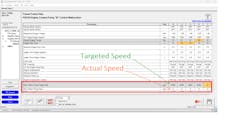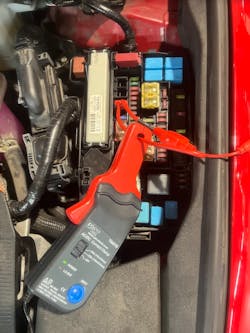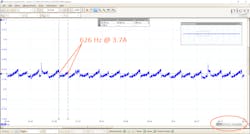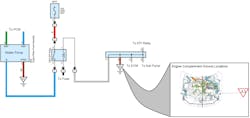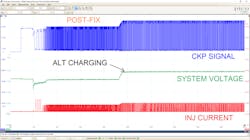Content brought to you by Motor Age. To subscribe, click here.
Welcome back to another edition of “The data doesn’t lie,” a regular feature in which I pose a puzzling case study, followed by the answers to the previous issue’s puzzle.
What You Will Learn:
• Don't repair the symptom, locate and repair the cause of the symptom
• Always reference a wiring diagram before approaching an electrical fault
• Bi-directional controls allow you to see the entire system function together instead of a single component
Keeping true to the theme of always trying to find the root-cause fault, and as efficiently as possible, this next interactive case study comes from a great friend of mine, Steve. He was issued a repair order for a 2015 Lexus CT200h with the complaint of the MIL being illuminated. He retrieved the vehicle from the lot, and it operated well under its own power. Steve scanned the PCM for DTCs and noted only one, a P261B "engine coolant pump-B control malfunction."
As with many of today's vehicles, this vehicle's water pump is driven electrically rather than by the accessory drive belt. This allows for more efficient engine thermal management. For instance, by slowing pump speed, engine warmup time can be shortened. And increasing pump speed can provide better heat transfer under high engine loads.
Capitalizing on what the tools can provide
I've known this guy for a few years now, and he has a knack for extracting data from vehicles in a fashion in which he can make efficient diagnostic decisions without extensive disassembly or wasted time (time spent on unnecessary testing). True to form, Steve navigated the scan tool to view the freeze-frame data. This data can be of great value, as it is recorded at the time of the flagged DTC. Noted in the freeze-frame was the targeted vs. actual water pump speed (Figure 1). What should be obvious is that the apparent speed of the water pump is not what is being commanded. Still comfortably seated in the driver's seat, Steve then navigated the scan tool to allow bidirectional control of the electric coolant pump. Giving command to the pump, something very strange occurred. First, Steve noted two distinctions:
- When commanded to run, the water pump made an unusual sound.
- After commanding the pump on (for approximately ten seconds), then off, the pump couldn't be commanded on a second time.
Gaining diagnostic direction
Both characteristics would prove to be noteworthy. This is what led to the test he performed next to evaluate the condition of the pump. He implemented the lab scope and a current probe (Figure 2). Both these devices worked together to indicate pump operating speed, motor condition, and load on the motor (how much work is being performed). The best part is since this data doesn't have to be collected at the coolant pump, it can be acquired easily at the fuse box.
Referencing the capture of the suspect coolant pump, the information was acquired when the scan tool command was issued. The most notable characteristic was the seemingly low mechanical load on the pump (reflected by the low amplitude of current flow indicated by the amp probe trace).
Expecting approximately 10A, it's clear that something was not quite right, with the pump circuit drawing fewer than 4A (Figure 3). What Steve also noticed is that when the pump failed to operate under command from the scan tool, the coolant pump circuit current registered as zero. This led him to refer to a wiring diagram (Figure 4).
The data doesn't lie
With all the information in front of him, he was faced with deciding how to proceed. Here are some bullet points of what we know to be factual, and I will ask all of you, diligent readers, for your input:
- Initially, the coolant pump functions under scan tool command. However, the coolant pump fails to function on a subsequent command attempt
- During circuit testing (while under scan tool command/no pump operation) voltage is not present at the output side/Terminal #5 of the W/P relay
- The front of the car looked particularly shiny
Putting the puzzle pieces of data together, the answer to both the following questions can be found in the wiring diagrams:
- Why might the coolant pump initially function under scan tool command but fail to function on a subsequent attempt?
- Where is the most logical location for the next test or correction?
Given this information, what would you recommend doing next?
- Replace electric water pump
- Replace electric water pump relay
- Reprogram PCM to correct for faulty software
- Remove bumper for further testing, more unanswered questions
SOLVED: (March. 2023 Motor Age) 1994 Ford Ranger 2.3L, Stall unless alternator disabled
What would you recommend doing next, given the data bullet points in last month's challenge?
- Replace PCM
- Overlay new circuitry for fuel injectors
- Replace ICM
- Attempt to locate known-good scope captures in technician forums
For those of you who chose answer #4, congratulations! This is the most responsible approach. I will be the first to tell you that this was an extremely difficult conclusion to draw. In fact, I now have over eight weeks of research involved, down to the circuit board level of this Ranger's PCM!
I researched forums far and wide and found that the incoming PIP signal (between ICM and PCM) was indeed of lower amplitude on the suspect vehicle when compared to a known-good waveform. So, too, was the incoming CKP signal (from sensor to ICM). In fact, when referencing an "expected values" chart provided by service information, the amplitude of both those signals was lower by almost 5V.
The confusion sets in because (with that alternator disconnected) the engine runs and performs well under all operating conditions, even with the signals toggling between only 0-6.7V. While the alternator is connected/charging, the signals are of taller amplitude. They then attain amplitudes of approximately 0-7.5V (a 12-percent improvement) before the engine suddenly stalls. However, the known-good signals are of approximately 0-12V whether the alternator is connected or not.
My final decision was to replace the ICM. With the CKP sensor being of a pull-down circuit design (hall-effect sensor), the ICM is the source of the incoming CKP signal's reference voltage, and the sensor toggles the reference voltage to ground. Achieving only 7.5V of amplitude, the circuit was loaded internally to the existing aftermarket ICM. This is the only logical reason for replacing the ICM. I simply hoped it would fix the stalling symptom.
Although I'm still in pursuit of why the PCM stopped driving the fuel injectors (causing the stall), replacing the IMC fixed the CKP reference voltage, which corrected the outgoing PIP signal (ICM to PCM), and the vehicle functions as designed without stalling. If I can learn how this PCM's chip process the incoming PIP signal, I believe I will have the answer I seek. This information may or may not be possible to acquire but I will keep you posted!
Be sure to read next month's Motor Age issue for the answer to this month’s challenge and what was discovered!
About the Author
Brandon Steckler
Technical Editor | Motor Age
Brandon began his career in Northampton County Community College in Bethlehem, Pennsylvania, where he was a student of GM’s Automotive Service Educational program. In 2001, he graduated top of his class and earned the GM Leadership award for his efforts. He later began working as a technician at a Saturn dealership in Reading, Pennsylvania, where he quickly attained Master Technician status. He later transitioned to working with Hondas, where he aggressively worked to attain another Master Technician status.
Always having a passion for a full understanding of system/component functionality, he rapidly earned a reputation for deciphering strange failures at an efficient pace and became known as an information specialist among the staff and peers at the dealership. In search of new challenges, he transitioned away from the dealership and to the independent world, where he specialized in diagnostics and driveability.
Today, he is an instructor with both Carquest Technical Institute and Worldpac Training Institute. Along with beta testing for Automotive Test Solutions, he develops curriculum/submits case studies for educational purposes. Through Steckler Automotive Technical Services, LLC., Brandon also provides telephone and live technical support, as well as private training, for technicians all across the world.
Brandon holds ASE certifications A1-A9 as well as C1 (Service Consultant). He is certified as an Advanced Level Specialist in L1 (Advanced Engine Performance), L2 (Advanced Diesel Engine Performance), L3 (Hybrid/EV Specialist), L4 (ADAS) and xEV-Level 2 (Technician electrical safety).
He contributes weekly to Facebook automotive chat groups, has authored several books and classes, and truly enjoys traveling across the globe to help other technicians attain a level of understanding that will serve them well throughout their careers.

